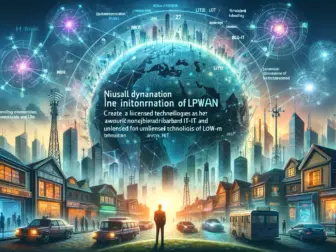Tag - 2024 LPWAN
Exploring the Future: The 2024 LPWAN Revolution Enabling Ubiquitous IoT Connectivity
As we approach the year 2024, the landscape of Low Power Wide Area Networks (LPWAN) is undergoing a transformative change, signaling the dawn of a new era for the Internet of Things (IoT). LPWAN technologies are set to redefine connectivity, bringing to life the vision of a truly ubiquitous IoT ecosystem. These networks, known for their long-range communication capabilities and low power consumption, are evolving to meet the ever-growing demands of industries and smart cities.
One of the key advancements in 2024 LPWAN technology is the enhanced data transmission rates. With IoT devices proliferating at an exponential rate, the need for higher bandwidth to support complex applications has become critical. Innovations in modulation techniques and spectrum efficiency have allowed LPWANs to facilitate not just higher data rates but also improved reliability and lower latency, making them ideal for applications like real-time asset tracking, smart metering, and precision agriculture.
Another groundbreaking development is the integration of artificial intelligence (AI) and machine learning (ML) within LPWAN infrastructure. This integration is enabling smarter network management, with self-optimizing capabilities that enhance performance and scalability. AI-driven predictive maintenance and anomaly detection further ensure network reliability, reducing downtime and maintenance costs for large-scale IoT deployments.
Battery life remains a paramount concern for IoT devices, and 2024 LPWAN technologies are addressing this head-on. Through the adoption of energy-harvesting techniques and advancements in battery technology, IoT sensors and devices can now operate for years without the need for battery replacement. This not only reduces the total cost of ownership but also makes it feasible to deploy IoT solutions in remote and hard-to-reach areas.
Interoperability is another area where substantial progress has been made. The LPWAN landscape has traditionally been fragmented, with multiple competing standards. However, recent efforts towards standardization and the emergence of cross-compatible platforms are enabling devices to communicate seamlessly across different LPWAN technologies. This development is crucial for the creation of a cohesive and interconnected IoT environment, which is essential for the realization of smart city initiatives and large-scale industrial IoT applications.
As we look towards the future, it is clear that LPWAN technologies will continue to play a pivotal role in the expansion of IoT. The advancements seen in 2024 are not just enhancing the capabilities of individual devices but are also fostering a connected world where data-driven insights lead to smarter decisions and more efficient operations. The LPWAN revolution is well underway, and its impact on various sectors—from agriculture to healthcare, from logistics to environmental monitoring—is set to be profound and far-reaching.
